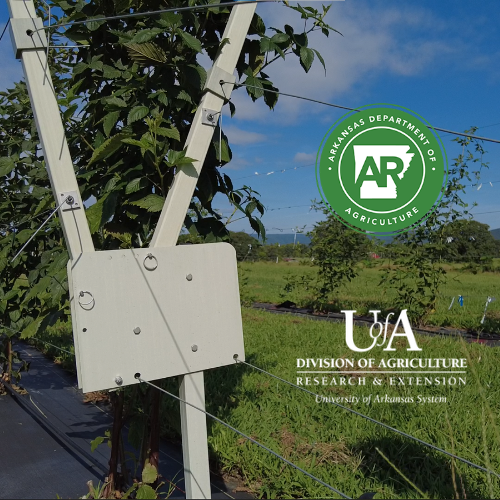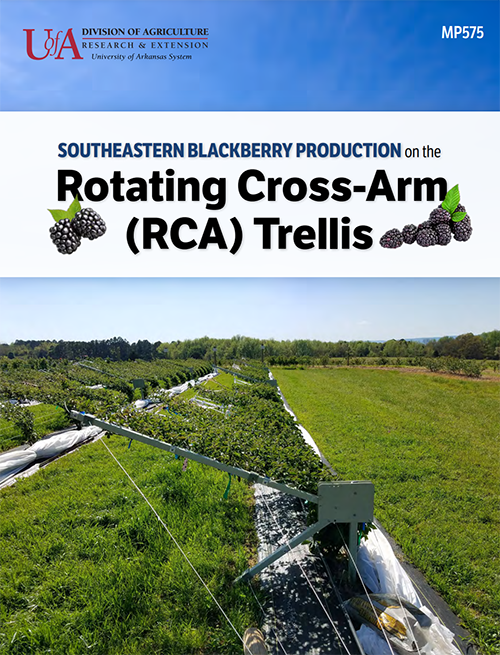Contact
Dr. Amanda McWhirt
Fruit and Vegetable Crops, Horticulture Specialist
Phone: 501-671-2229
Email: amcwhirt@uada.edu
Dr. Aaron Cato
IPM for Horticulture Crops, Horticulture Specialist
Phone: 479-249-7352
Email: acato@uada.edu
Recommendations for the Rotating Cross-Arm (RCA) Trellis in Blackberry Systems

Moveable trellising systems like the rotating cross-arm trellis (RCA) have grown in popularity among blackberry growers in the Southeast to combat extreme weather impacts on blackberry production. Horticulture production extension specialist Dr. Amanda McWhirt and her team have been conducting research at the University of Arkansas Fruit Research Station in Clarksville, Arkansas studying the effects of the RCA trellis on yield, fruit quality, and labor.
Through this research, various resources have been developed to provide information on the best management practices for blackberries on an RCA trellis system.
Video Series 🎥

MP575: Southeastern Blackberry Production on the Rotating Cross-Arm (RCA) Trellis Handbook
This handbook is meant to guide new users in efficiently managing blackberries on the Rotating Cross-Arm (RCA) trellis. Topics include:
- What are moveable and rotating cross-arm (RCA) trellises?
- Benefits
- Limitations
- Economics
- RCA trellis design and components
- Getting started with RCA trellises for Blackberry
- Cane and Canopy Management
Download the RCA Handbook Here
FAQ
A: Atlas Greenhouse is a commercial option. Many growers work with a local metal fabricator to build their own trellis arms. General dimensions for the trellis are in the Southeastern Blackberry Production on the Rotating Cross-Arm (RCA) Trellis Handbook. Fiberglass materials do tend to crack after several years but can be patched. Aluminum trellis arms tend to hold up better over time.
A: In the Southeast we only suggest laying the RCA down to the winter position if the forecast calls for temperatures below 10℉ F and the grower plans to apply a row cover. Temperatures at ground level can be a few degrees cooler than in the canopy if the trellis is left standing up. Thus we don’t recommend laying the RCA trellis down in winter and not applying a row cover.
In more northern locations where winter temperatures remain consistently cold and snow cover is more persistent, the trellis can be laid over just before the first frost and covered for the winter with a row cover.
Be aware that for locations that experience fluctuating winter temperatures the RCA should not be covered and laid over in the winter position for extended periods of time. Temperatures under the row cover on a warm and sunny day can easily be 10+ degrees warmer than the outside air, which can risk delaying the onset of winter dormancy or risk early bud break which could result in more cold injury to the crop.
A: In the Southeast row covers will only need to be applied on an ‘as needed’ basis when temperatures are predicted to fall below 10℉ during the dormant period. All growers should plan to use row covers is temperatures below 30-32℉ are predicted during bloom or early bud break.
We suggest getting 1oz row covers that are 12-15 feet wide to cover individual rows. Pull the entire row cover down the upwind side of the row. Weigh one edge of the cover down with rock bags or t-posts. Then start at one end and use the wind to help pull the other edge of the cover across the row. Secure the other side of the cover to the ground. At the end of the rows the row cover can be gathered under the wires toward the tie back post and weighed down. Avoid leaving large gaps where the row cover does not meet the ground to minimize heat loss or prevent wind from tearing the covers.
We have experimented with using ¼’’ pvc pipes to create hoops that are attached to the trellis arms to help keep the row cover up off the canes. This method works well to keep the row cover from being pulled taut against the canes or shoots; and to minimize the row cover being caught on the trellis arm plate. Plant parts that are in contact with the row cover may still be injured by cold temperatures and using these hoops minimizes plant contact with the row cover. The pvc pipes can be secured on to short pieces of rebar anchored in the ground to hold the hoops upright.
A: The trellis should be laid over into the bloom position at or just prior to budbreak. Once the petals start to fall on early blooms and the start of small green fruit is visible the trellis can be stood up to the harvest position.
A: We suggest leaving all the tipped primocanes until August when the floricanes are removed and the primocanes are transferred to the long-arm. At this time an inventory of the main canes and lateral canes can be made. Any weak canes that are not needed to get full trellis fill on the long-arm can be removed to ground level or extra laterals can be cut back to the main cane that was tipped. Lateral canes should be placed at fist width (4-5’’) distance apart on the long-arm.
A: No! The ends of lateral canes should not be cut in late summer. Cutting the end of the canes in late summer can initiate the development of side branches on the lateral canes, which is undesirable. We suggest leaving the canes until late fall or early winter, when they can be cut 6’’ past the top wire. The long laterals can also be looped back down on the long-arm to fill in places where there is inadequate trellis fill.
Additional Resources
- MP574: What is Wrong with My Blackberry? Identifying Fresh-Market Blackberry Disorders, University of Arkansas System Division of Agriculture
- FSA6130: Small Fruit Cultivar Recommendations for Arkansas, University of Arkansas System Division of Agriculture
- FSA7088: Monitoring for Spotted-Wing Drosophila in Blackberry in Arkansas, University of Arkansas System Division of Agriculture
- Impact of Trellising on Spray Coverage and Spotted-Wing Drosophila Infestation: Comparing the Rotating Cross-Arm Trellis to the T-Trellis, University of Arkansas System Division of Agriculture, XIII International Rubus and Ribes Symposium
- Rotating Cross-Arm Trellis Offers Improved Yields, Quality for Blackberries, University of Arkansas System Division of Agriculture
We would like to thank the Arkansas Department of Agriculture Specialty Crop Block Grant program for supporting this project and the production of these resources.
